Eating Disorders
- Serious mental disorders;
- Obsession with food or body shape;
- Abnormal eating habits;
- Types include:
- Anorexia nervosa;
- Bulimia nervosa;
- Binge eating disorder;
- Pica;
- Rumination disorder;
- Physical, social, and psychological effects.
Eating disorders encompass a wide variety of illnesses that are characterized by abnormal eating habits, obsession with body image, and sudden weight fluctuations. They are complex diseases that affect all classes of people. Eating disorders are recognized as mental health disorders because pf their psychological effects. They can have life-threatening effects if they are not treated properly. The most common types include anorexia nervosa, bulimia nervosa, pica, rumination disorder, binge eating disorder, and restrictive or avoidant food intake eating disorder (National Institute of Mental Health, 2019). Others include night eating syndrome and purging disorder. It is important for eating disorders to be treated and managed adequately because they have serious physical, social, and psychological effects on patients.
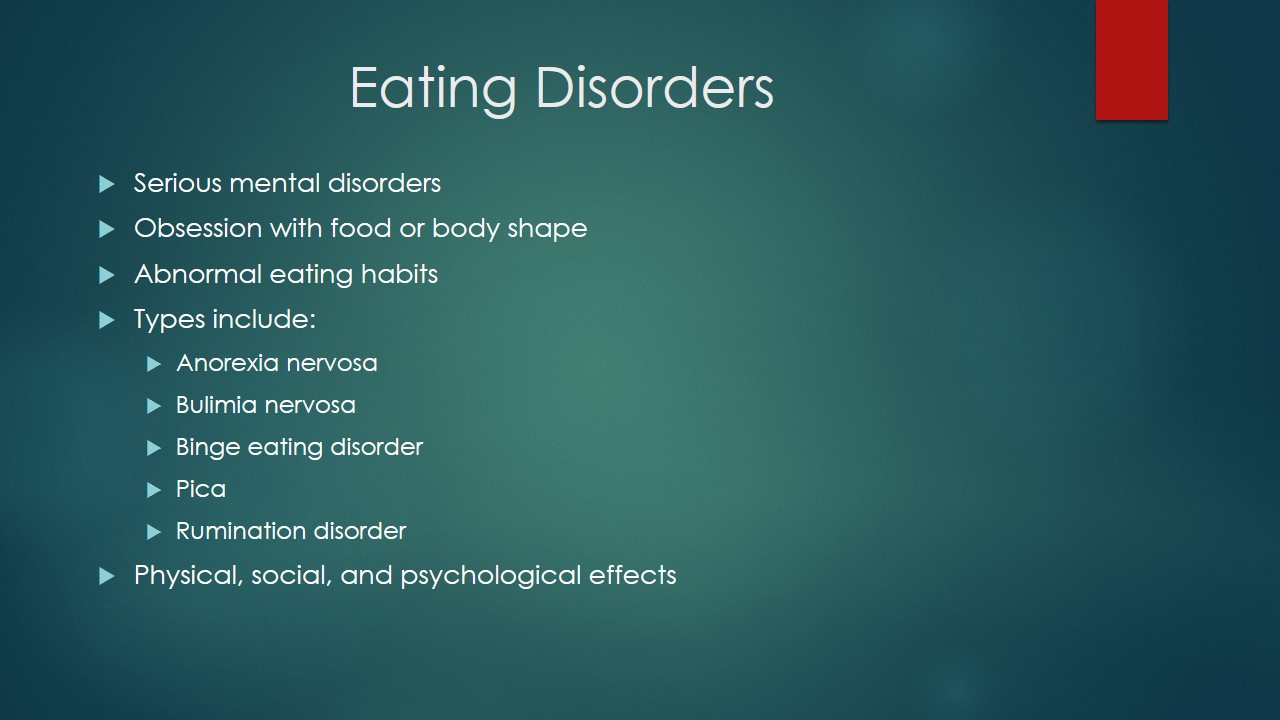
Risk Factors
- Biological factors:
- Negative energy balance;
- Dieting history;
- Type 1 diabetes;
- Psychological factors:
- Perfectionism;
- Depression;
- Anxiety;
- Poor body image.
- Social factors:
- Weight stigma;
- Bullying;
- Acculturation;
- The influence of the media;
- The search for perfection;
- Career influence:
- Models;
- Athletes;
- Dancers.
The risk factors for eating disorders encompass a wide range of biological, psychological, and social factors. Biological factors include a history of dieting, type 1 diabetes, negative energy balance, and the presence of an eating disorder in the family’s genetic line (Hilbert et al., 2014). A family member with an eating disorder increases the likelihood of its development in other members. Negative energy balance results from the burning of excessive calories due to factors such as dieting, intense physical activity, or illness (Hilbert et al., 2014). Research has shown that women with type 1 diabetes are at high risk of developing an eating disorder. Psychological factors include perfectionism, behavioral inflexibility, and dissatisfaction with one’s body image (Hilbert et al., 2014). Social factors include weight stigma, bullying or teasing, acculturation, historical trauma, and limited social networks.
In many cultures, thinness is presented as the main indicator of beauty. Therefore, many women develop eating disorder in search for beauty. Moreover, the presentation of beauty in the media is misleading. Many people adopt unhealthy eating habits in order to attain a perfect body image. It is also common in today’s society for human value to be based on physical appearance. The pursuit for perfection and societal acceptance leads many people to develop eating disorders that compromise their health and overall well-being. Many careers place great emphasis on body image. For instance, individuals who want to become dancers, models, and athletes have attain a certain body shape and size in order for them to succeed in their careers.
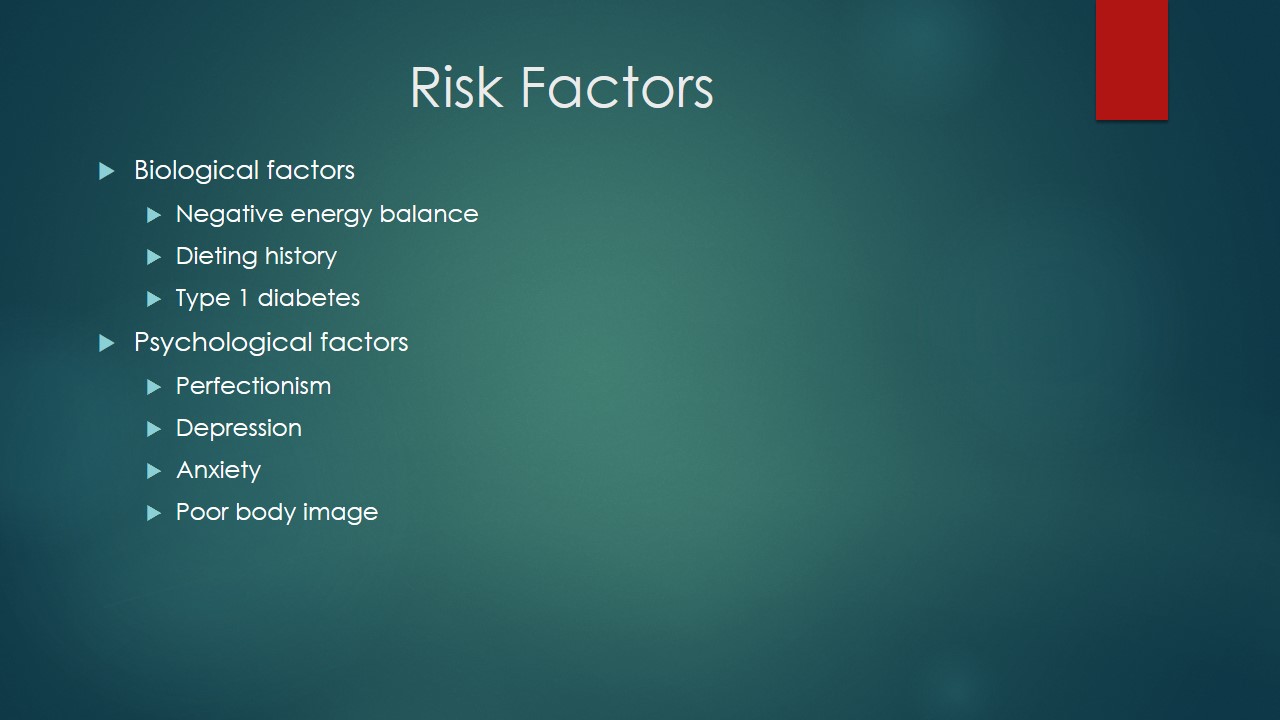
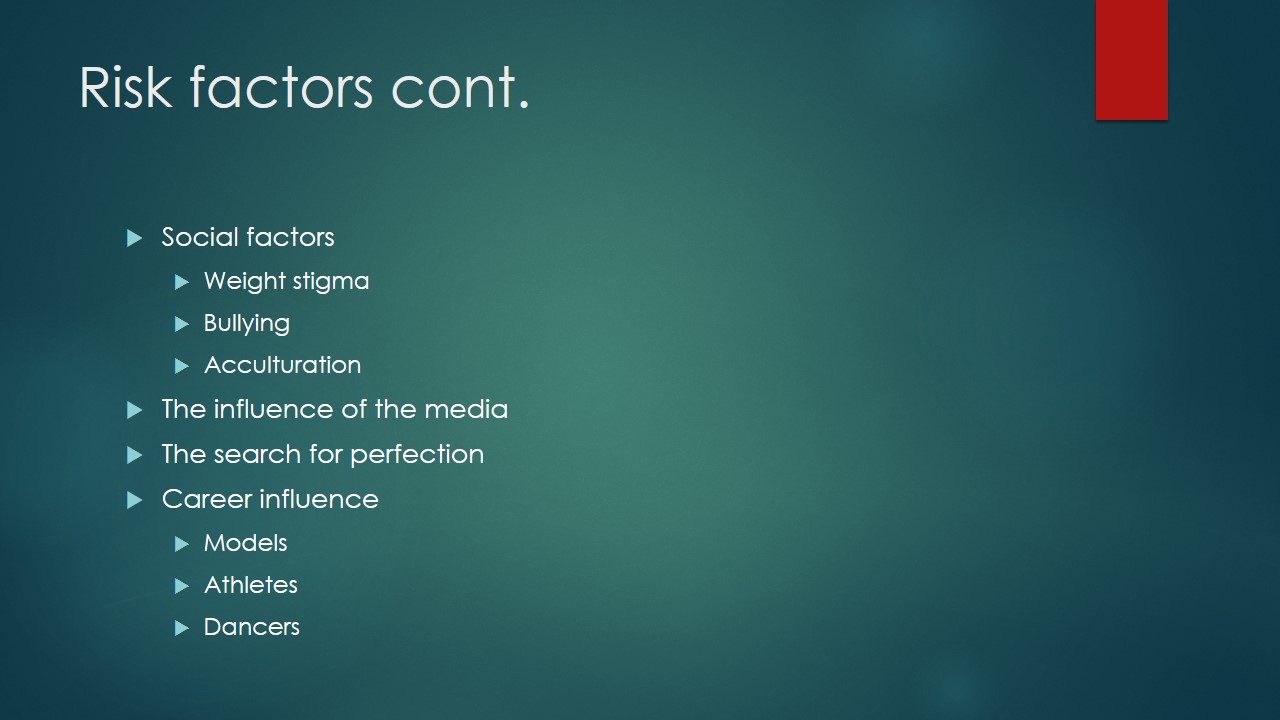
Signs
- Emotional and behavioral:
- Preoccupation with weight and food;
- Obsession with dieting and body image;
- Isolation;
- Food rituals;
- Depression;
- Low self-esteem;
- Skipping meals;
- Extreme mood swings;
- Physical:
- Dizziness;
- Difficulties concentrating;
- Weight fluctuations;
- Mental irregularities;
- Sleep problems;
- Muscle weakness;
- Impaired immune functioning.
Signs of eating disorders can be grouped into two main classes: physical and emotional/behavioral. Emotional and behavioral signs include preoccupation with food, weight loss, as well as body shape and size (National Institute of Mental Health, 2019). Individuals refuse to eat certain food and they have certain rituals that they follow. They skip meals, diet frequently, withdraw from friends, and experience extreme mood swings. In addition, they are obsessed with checking themselves in the mirror for perceived physical flaws (National Institute of Mental Health, 2019). Physical signs include abnormal weight fluctuations, dizziness, muscle weakness, fainting, difficulties concentrating, yellow skin, menstrual irregularities, and dry skin and hair (National Institute of Mental Health, 2019). Others include stomach cramps, poor wound healing, and impaired immune functioning.
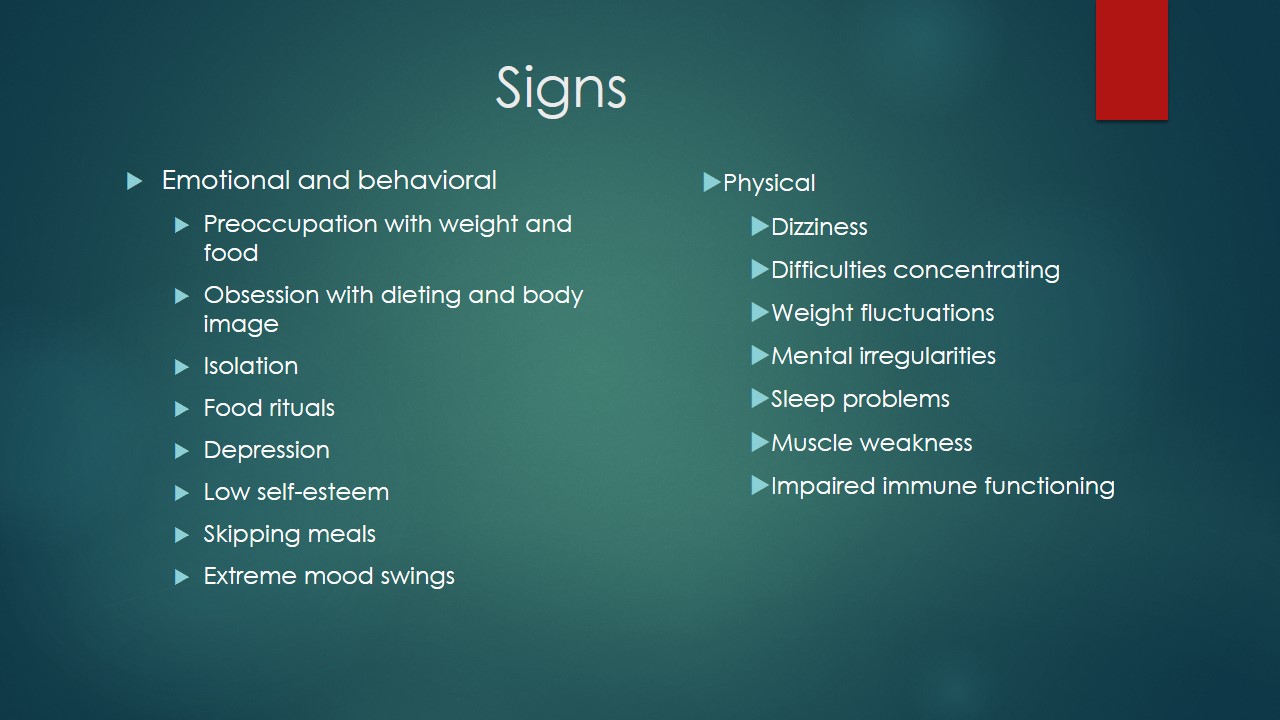
Prevalence/Incidence
- Affects people of all ages/sex.
- More common in women than men.
- 500,000 teenagers affected.
- Affects 30 million women.
- Affects 10 million men.
- Incidence rate:
- Anorexia nervosa: 8 cases in every 100,000.
- Bulimia nervosa: 12 cases per 100,000.
- Prevalence rates:
- Bulimia nervosa: 1%.
- Binge eating disorder: 1%.
According to government statistics, eating disorders affect people of all ages. However, they are more common among children and women. Moreover, they are more prevalent in women than in men. Approximately 30 million women and 10 million men have an eating disorder in the United States of America (National Institute of Mental Health, 2019). Statistical estimates show that about 500,000 teenagers have an eating disorder in the US. The incidence rate varies depending on the type of disorder. For example, the incidence rate for anorexia nervosa is 8 cases in a population of 100,000 while for bulimia nervosa, the rate is 12 cases for every 100,000 people annually. The prevalence rates for bulimia nervosa and binge eating disorder is 1%.
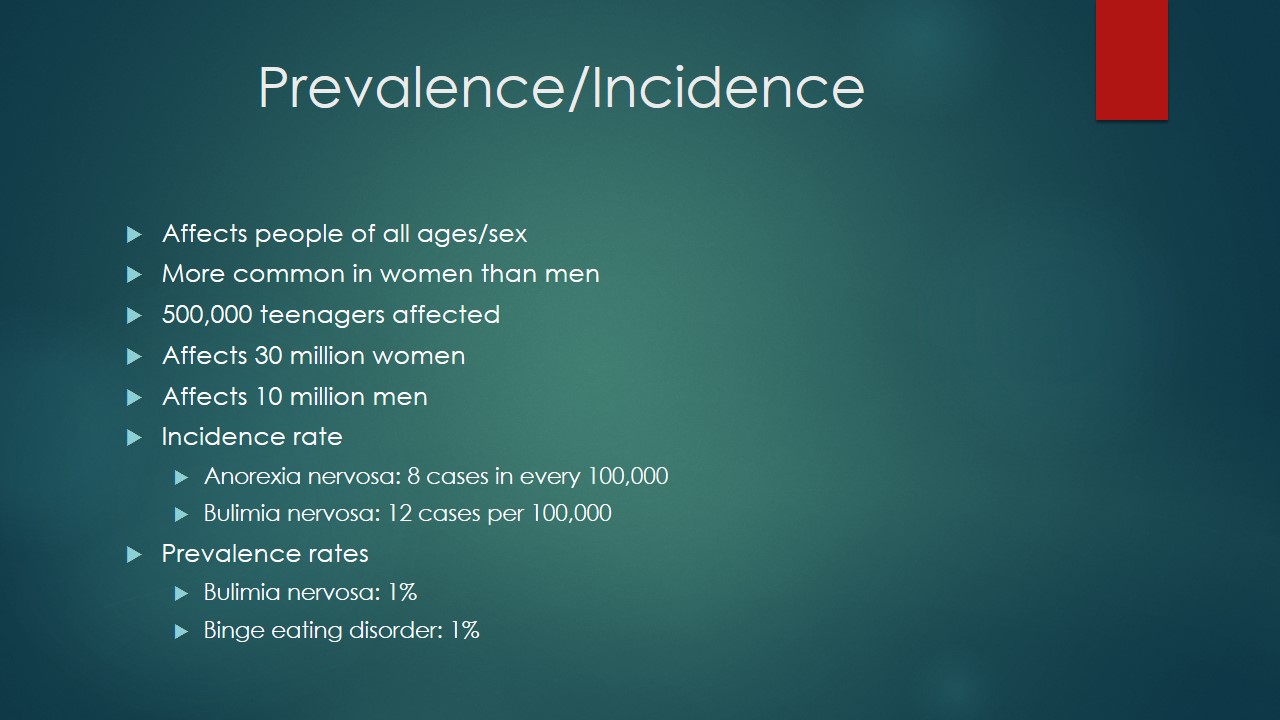
Treatment Options
- Treatment based on disorder and symptoms;
- Psychological therapy (psychotherapy);
- Nutrition education;
- Medication;
- Medical monitoring;
- Addressing related health problems;
- Psychotherapy the most effective method;
- Types include:
- Acceptance and commitment therapy (ACT);
- Cognitive behavioral therapy (CBT);
- Cognitive remediation therapy (CRT);
- Dialectical behavior therapy (DBT);
- Evidence based treatment;
- Family-based Treatment (FBT);
- Interpersonal psychotherapy (IPT).
The most effective treatment option for eating disorders includes a combination of psychological therapy, nutrition education, and medication. A treatment team could include a psychologist to provide psychotherapy, a dietitian to offer nutrition education, and a psychiatrist to prescribe drugs (National Eating Disorders Association, 2019). Psychotherapy is the key component of treatment that helps patients to normalize their eating habits, improve moods, and relationships, develop healthy eating habits, and embrace healthy wats to handle stress (National Institute of Mental Health, 2019). Physicians can choose from a wide range of options: cognitive behavioral therapy, family-based therapy, or group cognitive behavioral therapy (National Eating Disorders Association, 2019). Nutrition education teaches patients how to plan their meals, understand the effect on nutrition on the body, establish proper eating patterns, and maintain a healthy body weight. Medications work when they are prescribed to supplement therapy. Antidepressants are administered to patients with bulimia or binge-eating disorder (National Eating Disorders Association, 2019). Some physicians prescribe drugs that address the health problems that result from a patient’s eating disorder.
Psychotherapy is the most effective treatment method. It is aimed at helping patients change their attitudes and behaviors towards food and body shape and size. Various types of therapies work differently in people. The major goal of treatment is to reduce eating behaviors. Acceptance and commitment therapy helps patients to change their actions, embrace detachment from emotions, and embrace the fact that pain and anxiety are vital life components (National Eating Disorders Association, 2019). Cognitive behavioral therapy focuses on patients’ beliefs, attitudes, and values that encourage certain unhealthy eating behaviors (National Institute of Mental Health, 2019). Individuals learn how to adjust their beliefs about weight and body image. Cognitive remediation therapy helps patients to focus on multiple things in order to terminate rigid thinking processes (National Eating Disorders Association, 2019). Dialectical behavior therapy focuses on instilling in patients skills that help them to replace unhealthy eating behaviors (National Eating Disorders Association, 2019). Family-based treatment focuses on the restoration of weight in order to promote recovery (National Eating Disorders Association, 2019). It is effective in the treatment of adolescents with bulimia and anorexia. Psychodynamic psychotherapy involves treating eating disorders from the perspective of understanding its cause.
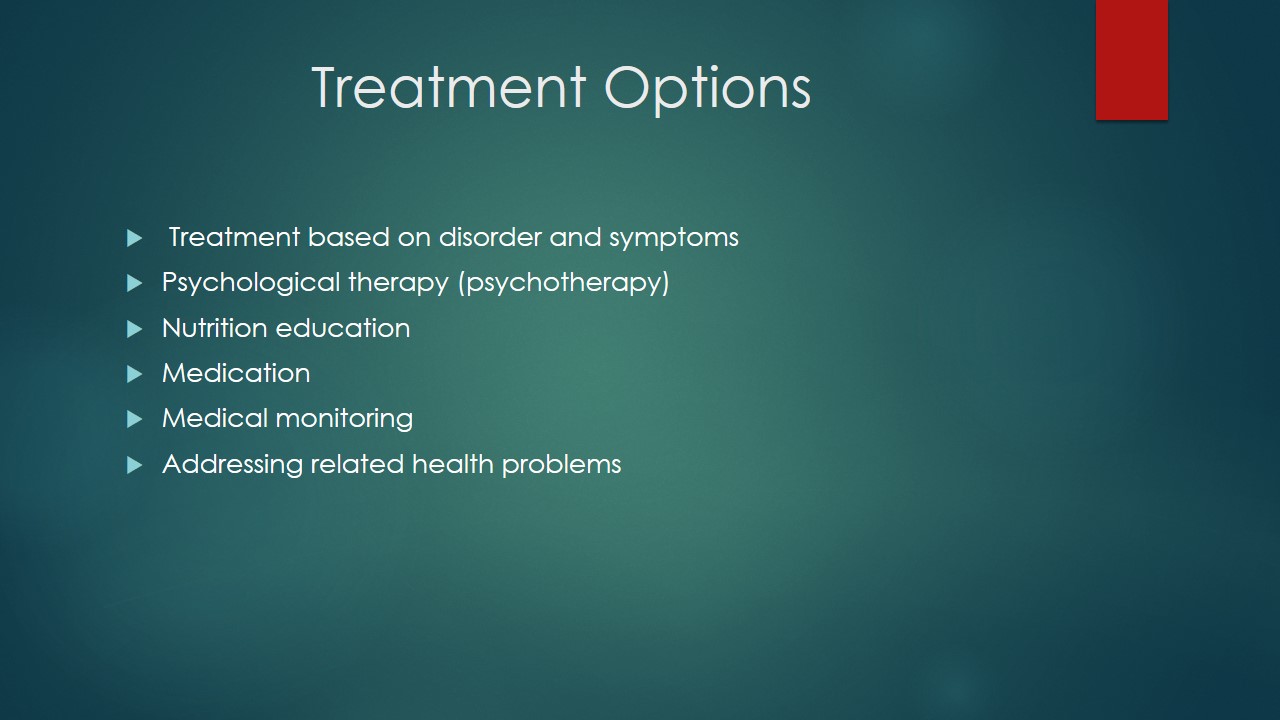
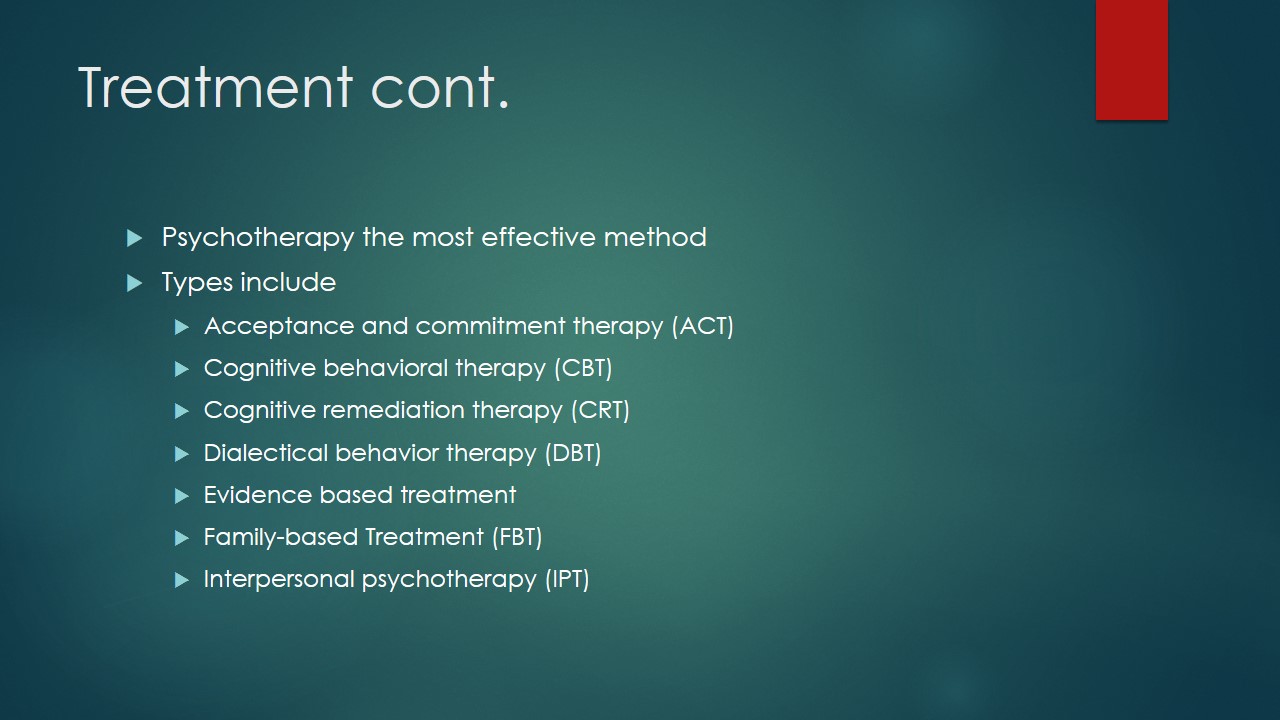
Treatment Types
- Determined by disorder severity.
- Outpatient treatment.
- Intensive outpatient treatment.
- Residential treatment.
- Inpatient/hospital treatment.
Eating disorders can be treated in various ways depending on their severity. The first option available is outpatient treatment that involves seeing a therapist. Health care professionals who provide services in outpatient treatment determine whether it is necessary for a patient to seek professional help level at a higher level of care (National Institute of Mental Health, 2019). If needed, they offer referrals to qualified physicians. Intensive outpatient treatment is offered to patients who are medically stable and who do not need close monitoring. Moreover, patients are psychologically stable to be able to function normally. Residential treatment is offered to patients show are psychiatrically unstable and who fail to respond to outpatient treatment (National Eating Disorders Association, 2019). Inpatient/hospital treatment is offered to patients who are both medically and psychiatrically unstable (National Eating Disorders Association, 2019).
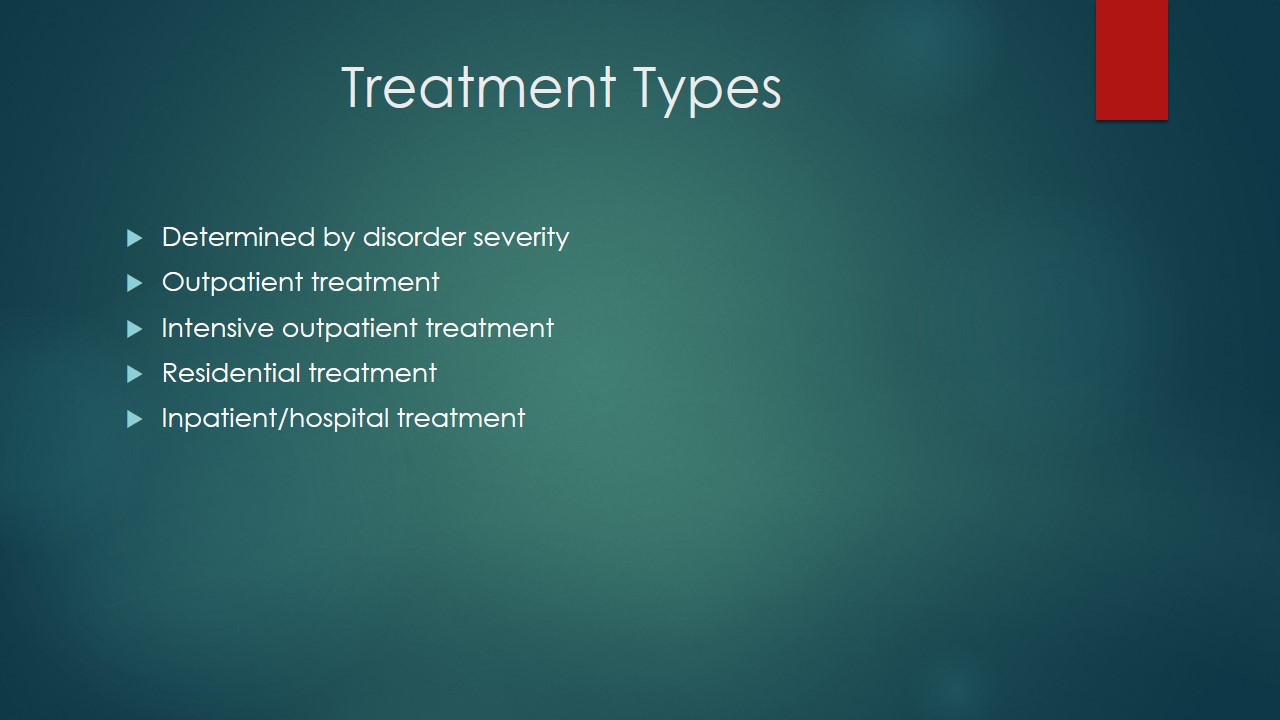
Resources
- Academy for Eating Disorders (AED);
- Eating Disorders Coalition (EDC);
- National Association of Anorexia Nervosa & Related Disorders;
- Binge Eating Disorder Association (BEDA);
- National Eating Disorder Association (NEDA);
- Active Minds;
- Bulimiahelp.org;
- Caringonline.com;
- International Association of Eating Disorders Professionals (IAEDP);
- Substance Abuse and Mental Health Services Administration (SAMHSA);
People with eating disorders can access several resources that are available online for information and referrals. Organizations that provide information on eating disorders include Academy for Eating Disorders, Eating Disorders Coalition, National Association of Anorexia Nervosa and Related Disorders, Binge Eating Disorder Association, and Active Minds. Others include the Substance Abuse and Mental Health Services Administration, the International Association of Eating Disorders Professionals, National Institute of Mental Health, and the Alliance for Eating Disorders Awareness. These organizations offer various services that are aimed at helping people with eating disorders. For example, the Alliance for Eating Disorders Awareness provides programs and activities that educate the public on health promotion issues such as positive body image and self-esteem. They offer information on how to prevent eating disorders. The National Eating Disorders Association (NEDA) offers assistance to families and individuals that are affected by eating disorders. They advocate for prevention and an equitable access to treatment. In addition, they provide funding to researchers who conduct studies to find new ways of treating and managing eating disorders.
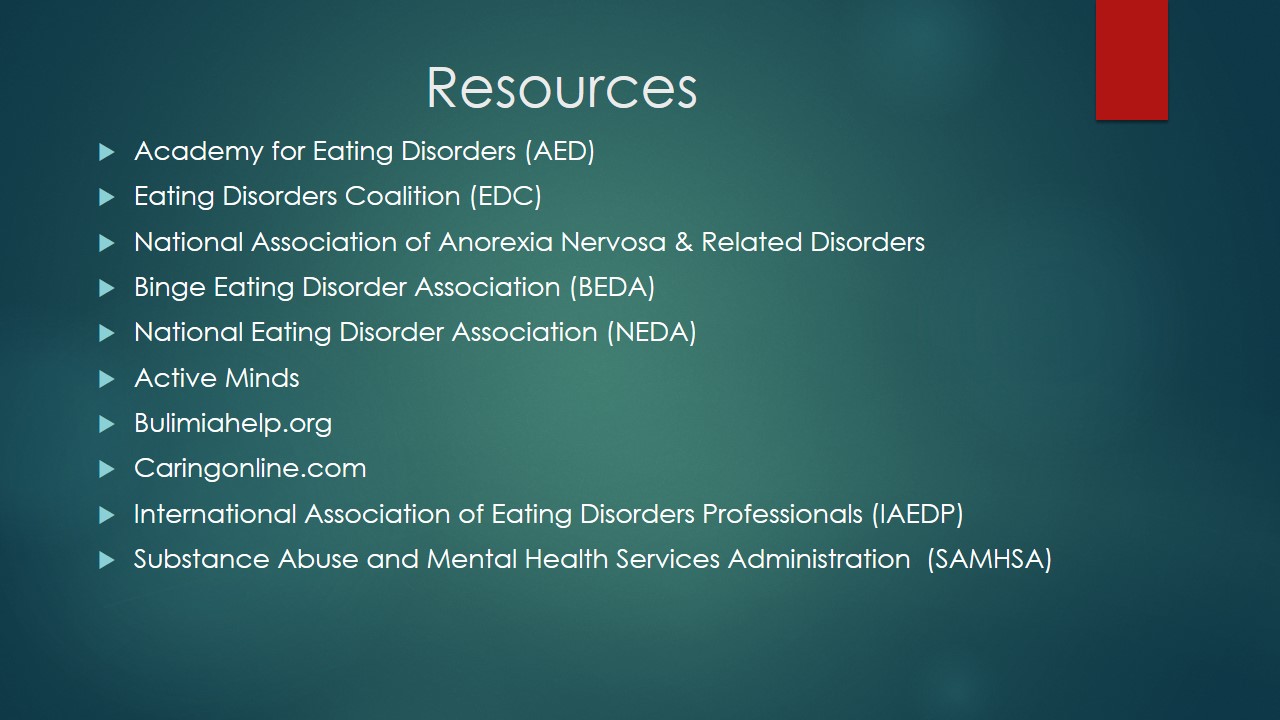
Conclusion
- Serious mental health disorders.
- Obsession with food and body image.
- Physical, behavioral, and psychological symptoms.
- Biological and social causes.
- Treatment options: therapy, education, medications.
- A wide range of resources.
Eating disorders are mental health illnesses that have serious consequences if they are not treated in a timely manner. Examples include anorexia nervosa, bulimia nervosa, pica, rumination disorder, binge eating disorder, and restrictive or avoidant food intake eating disorder. Each of these disorders has distinct signs. However, they all have common signs that include obsession with food and body image, mood swings, food rituals, weight fluctuations, and difficulties concentrating. The risk factors can be divided into three groups: psychological, biological, and social. Treatment options include psychological therapy, nutrition education, and medications. In many cases, a treatment team that includes a physician, a psychotherapist, a dietitian, and a psychiatrist is involved.
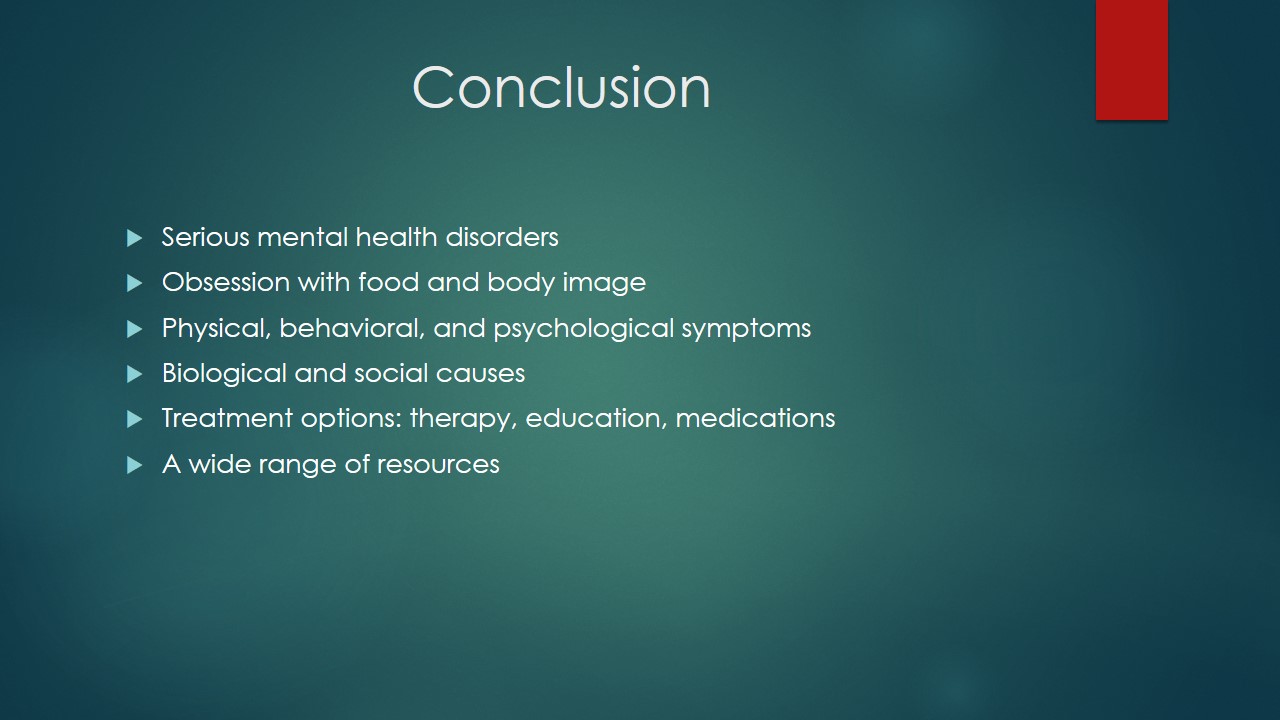
References
Hilbert, A., Pike, K., Goldschmidt, A., Wilfley, D., Fairburn, C., Dohm, F- A.,… Weissman, R. S. (2014). Risk factors across the eating disorders. Psychiatry Research, 1(2), 500-506.
National Eating Disorders Association (NEDA). (2019). Types of treatment. Web.
National Institute of Mental Health (NIMH). (2019). Eating disorders. Web.